Haonan Cheng
Detect All-Type Deepfake Audio: Wavelet Prompt Tuning for Enhanced Auditory Perception
Apr 09, 2025



Abstract:The rapid advancement of audio generation technologies has escalated the risks of malicious deepfake audio across speech, sound, singing voice, and music, threatening multimedia security and trust. While existing countermeasures (CMs) perform well in single-type audio deepfake detection (ADD), their performance declines in cross-type scenarios. This paper is dedicated to studying the alltype ADD task. We are the first to comprehensively establish an all-type ADD benchmark to evaluate current CMs, incorporating cross-type deepfake detection across speech, sound, singing voice, and music. Then, we introduce the prompt tuning self-supervised learning (PT-SSL) training paradigm, which optimizes SSL frontend by learning specialized prompt tokens for ADD, requiring 458x fewer trainable parameters than fine-tuning (FT). Considering the auditory perception of different audio types,we propose the wavelet prompt tuning (WPT)-SSL method to capture type-invariant auditory deepfake information from the frequency domain without requiring additional training parameters, thereby enhancing performance over FT in the all-type ADD task. To achieve an universally CM, we utilize all types of deepfake audio for co-training. Experimental results demonstrate that WPT-XLSR-AASIST achieved the best performance, with an average EER of 3.58% across all evaluation sets. The code is available online.
Temporal Variability and Multi-Viewed Self-Supervised Representations to Tackle the ASVspoof5 Deepfake Challenge
Aug 13, 2024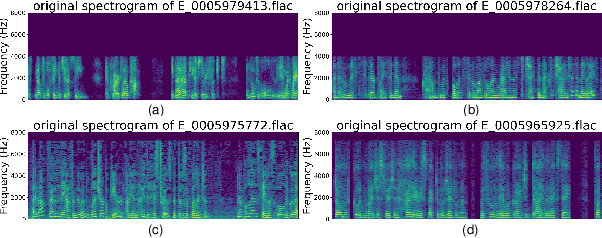
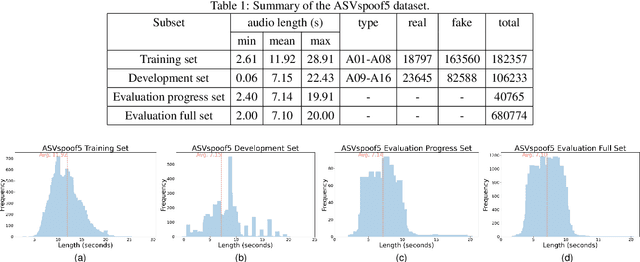
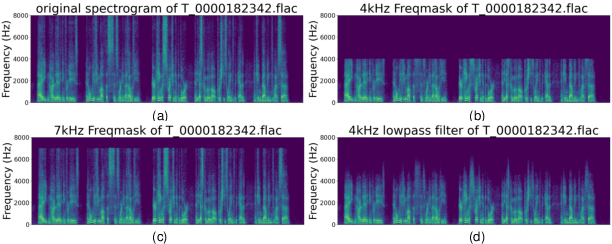
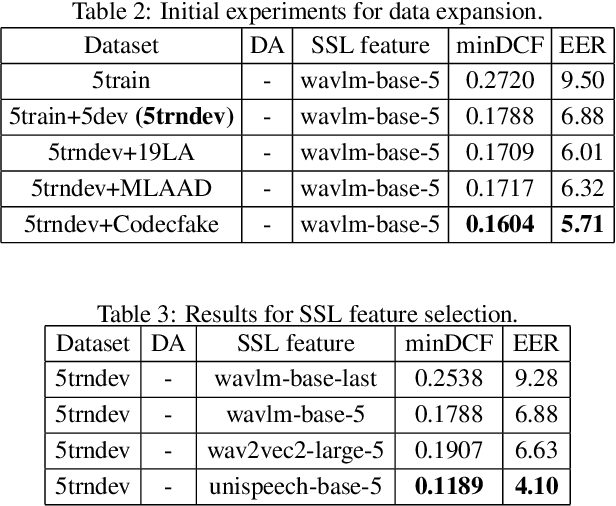
Abstract:ASVspoof5, the fifth edition of the ASVspoof series, is one of the largest global audio security challenges. It aims to advance the development of countermeasure (CM) to discriminate bonafide and spoofed speech utterances. In this paper, we focus on addressing the problem of open-domain audio deepfake detection, which corresponds directly to the ASVspoof5 Track1 open condition. At first, we comprehensively investigate various CM on ASVspoof5, including data expansion, data augmentation, and self-supervised learning (SSL) features. Due to the high-frequency gaps characteristic of the ASVspoof5 dataset, we introduce Frequency Mask, a data augmentation method that masks specific frequency bands to improve CM robustness. Combining various scale of temporal information with multiple SSL features, our experiments achieved a minDCF of 0.0158 and an EER of 0.55% on the ASVspoof 5 Track 1 evaluation progress set.
The Codecfake Dataset and Countermeasures for the Universally Detection of Deepfake Audio
May 08, 2024



Abstract:With the proliferation of Audio Language Model (ALM) based deepfake audio, there is an urgent need for effective detection methods. Unlike traditional deepfake audio generation, which often involves multi-step processes culminating in vocoder usage, ALM directly utilizes neural codec methods to decode discrete codes into audio. Moreover, driven by large-scale data, ALMs exhibit remarkable robustness and versatility, posing a significant challenge to current audio deepfake detection (ADD) models. To effectively detect ALM-based deepfake audio, we focus on the mechanism of the ALM-based audio generation method, the conversion from neural codec to waveform. We initially construct the Codecfake dataset, an open-source large-scale dataset, including two languages, millions of audio samples, and various test conditions, tailored for ALM-based audio detection. Additionally, to achieve universal detection of deepfake audio and tackle domain ascent bias issue of original SAM, we propose the CSAM strategy to learn a domain balanced and generalized minima. Experiment results demonstrate that co-training on Codecfake dataset and vocoded dataset with CSAM strategy yield the lowest average Equal Error Rate (EER) of 0.616% across all test conditions compared to baseline models.
FSD: An Initial Chinese Dataset for Fake Song Detection
Sep 06, 2023



Abstract:Singing voice synthesis and singing voice conversion have significantly advanced, revolutionizing musical experiences. However, the rise of "Deepfake Songs" generated by these technologies raises concerns about authenticity. Unlike Audio DeepFake Detection (ADD), the field of song deepfake detection lacks specialized datasets or methods for song authenticity verification. In this paper, we initially construct a Chinese Fake Song Detection (FSD) dataset to investigate the field of song deepfake detection. The fake songs in the FSD dataset are generated by five state-of-the-art singing voice synthesis and singing voice conversion methods. Our initial experiments on FSD revealed the ineffectiveness of existing speech-trained ADD models for the task of song deepFake detection. Thus, we employ the FSD dataset for the training of ADD models. We subsequently evaluate these models under two scenarios: one with the original songs and another with separated vocal tracks. Experiment results show that song-trained ADD models exhibit a 38.58% reduction in average equal error rate compared to speech-trained ADD models on the FSD test set.
An Efficient Temporary Deepfake Location Approach Based Embeddings for Partially Spoofed Audio Detection
Sep 06, 2023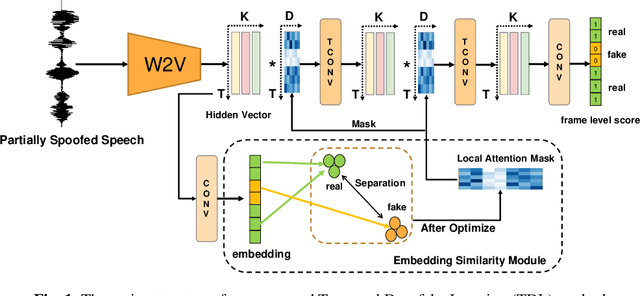
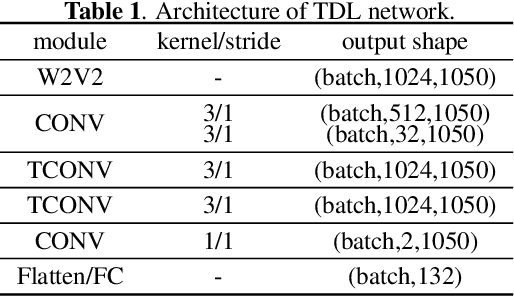
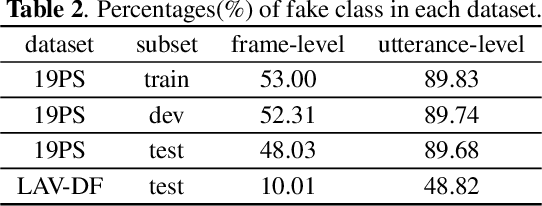
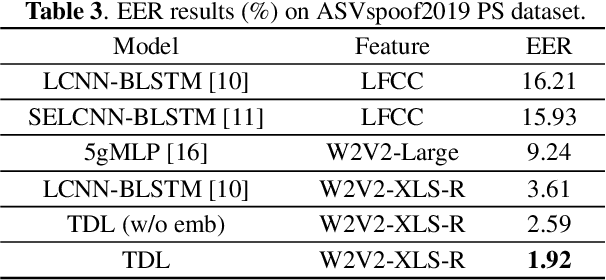
Abstract:Partially spoofed audio detection is a challenging task, lying in the need to accurately locate the authenticity of audio at the frame level. To address this issue, we propose a fine-grained partially spoofed audio detection method, namely Temporal Deepfake Location (TDL), which can effectively capture information of both features and locations. Specifically, our approach involves two novel parts: embedding similarity module and temporal convolution operation. To enhance the identification between the real and fake features, the embedding similarity module is designed to generate an embedding space that can separate the real frames from fake frames. To effectively concentrate on the position information, temporal convolution operation is proposed to calculate the frame-specific similarities among neighboring frames, and dynamically select informative neighbors to convolution. Extensive experiments show that our method outperform baseline models in ASVspoof2019 Partial Spoof dataset and demonstrate superior performance even in the crossdataset scenario. The code is released online.
 Add to Chrome
Add to Chrome Add to Firefox
Add to Firefox Add to Edge
Add to Edge